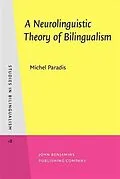This volume is the outcome of 25 years of research into the neurolinguistic aspects of bilingualism. In addition to reviewing the world literature and providing a state-of-the-art account, including a critical assessment of the bilingual neuroimaging studies, it proposes a set of hypotheses about the representation, organization and processing of two or more languages in one brain. It investigates the impact of the various manners of acquisition and use of each language on the extent of involvement of basic cerebral functional mechanisms. The effects of pathology as a means to understanding the normal functioning of verbal communication processes in the bilingual and multilingual brain are explored and compared with data from neuroimaging studies. In addition to its obvious research benefits, the clinical and social reasons for assessment of bilingual aphasia with a measuring instrument that is linguistically and culturally equivalent in each of a patient's languages are stressed. The relationship between language and thought in bilinguals is examined in the light of evidence from pathology. The proposed linguistic theory of bilingualism integrates a neurofunctional model (the components of verbal communication and their relationships: implicit linguistic competence, metalinguistic knowledge, pragmatics, and motivation) and a set of hypotheses about language processing (neurofunctional modularity, the activation threshold, the language/cognition distinction, and the direct access hypothesis).
